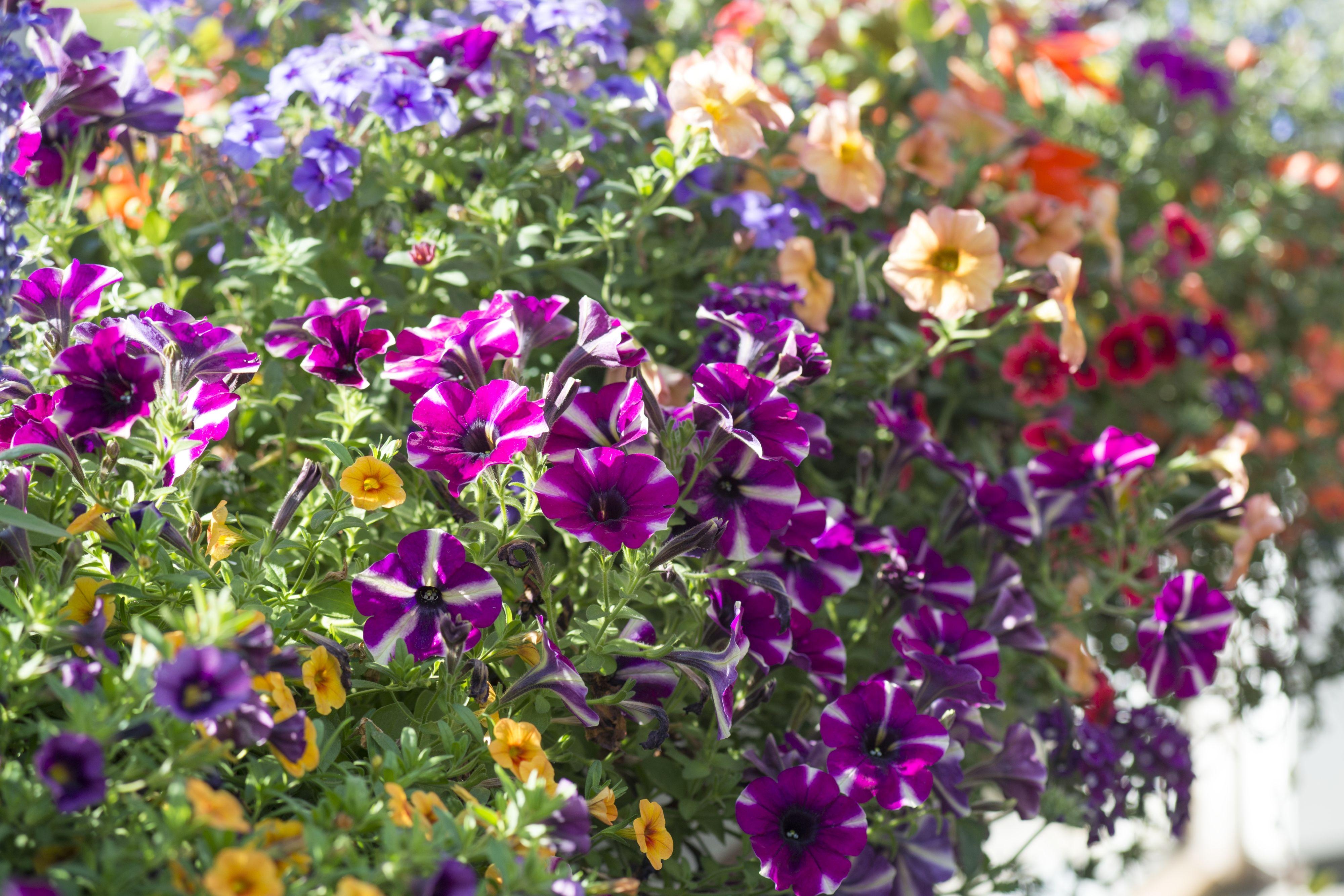Key Takeaways
- Petunias will keep blooming until frost with a little extra care.
- Provide regular water and fertilizer, and ensure at least 4 hours of direct sunlight.
- Deadhead frequently and prune back spindly stems to encourage new growth.
It’s common for petunias in pots to start fading out in late summer. The hanging basket or container that once was lush and full of blooms can fizzle after a couple of months. Signs your plants need attention include pale foliage, spindly new growth, and fewer new flowers. Use these simple tips to revive your petunias and bring back their flower power before frost arrives.
1. Keep Up with Watering
Dehydration is your most likely culprit for fading petunias. By late summer, those plants are large and require a significant amount of water to maintain. Hanging baskets, especially, are prone to dehydration, as their soil volume is limited, their drainage is excellent, and it’s easy for a large plant to use up the available moisture in short order.
Large petunias may require daily watering, or even twice daily in hot weather, especially when planted in pots or hanging baskets. Stick your finger into the soil and feel it. If the soil feels dry below the surface, it’s time to water. If you can’t even get your finger into the potting mix, see below for repotting instructions.
Potting mix can also become hydrophobic if it dries out excessively, like after you went away for the weekend and came back to wilted petunias. If water immediately runs back out of the container or basket, you’ll need to rehydrate the soil, either by setting the container in a tub with water in the bottom and letting it soak up, or by repeated waterings over the course of a couple of hours until the soil is moist and accepts water again.
2. Fertilize Regularly
When watering potted plants frequently, nutrients get washed out of the potting soil. To make matters worse, the small store of nutrients in potting mix when it was fresh is easily depleted in a matter of weeks. Even a potting mix that contains slow-release fertilizer can need supplementing by late summer.
If your potting mix has those little balls of fertilizer, or you added slow-release fertilizer when you planted the petunias, you won’t need to fertilize for a while. But, by midsummer or about 6-8 weeks after planting, it’s time to resume a regular fertilizer routine for potted plants. Choose a general-purpose, balanced liquid fertilizer and apply it approximately once a week when watering, diluting it in a watering can.
3. Deadhead Often
Most petunias need to be deadheaded to maintain their motivation to continue producing blooms. If allowed to develop seeds, that’s where they’ll put their energy, and flowering will decline. Keep petunias deadheaded for more blooms and a neater appearance.
Remember to remove the entire flower head, not just the spent petals. You’ll need to pinch off or snip below the bloom to remove the entire reproductive portion of the flower to get the full benefit of deadheading.
Related
4. Check Sunlight Levels
Petunias which don’t receive enough sunlight, like many plants, will get leggy and spindly, and bloom poorly. They thrive in full sun, and as the seasons shift, locations that were sunny may start to be shaded. The sun’s path for northern hemisphere gardeners will trend farther south in the sky as summer slides into early autumn. Trees and buildings will all cast more shadows, and for longer, than they did in late June.
If your potted petunias aren’t getting four hours of light a day or more (six hours is better), try moving them to a sunnier spot. It’s also common for the larger thriller plant in your container to get overly large by late summer, inadvertently shading your petunia. If possible trim it back a little.
5. Repot with Fresh Soil
Many nursery growers use a mix heavy in peat to grow petunias and other flowers. As the season progresses, this growing medium can become extremely hard and compacted, refusing to absorb water. You may think you’ve watered the plant because water runs out of the bottom of the basket, but really, there isn’t much available water for the roots to take up.
If you can’t stick your finger into the potting mix because it has gotten hard and compacted, try repotting the plant with fresh potting mix. Gently remove your petunia from its current pot, and free the roots, removing any old potting mix you can without doing too much damage. Replant it with fresh potting soil, perhaps in a slightly larger pot or basket. Water it thoroughly, and then resume regular watering whenever the soil feels dry. This is also a good time to prune your petunia.
6. Prune Petunias Back
Petunias, which have become disheveled and leggy, can be pruned back to put out fresh, green growth and new blooms. They can take a pretty heavy pruning, so don’t be afraid to cut them back hard. After all, if they look that bad, are you missing out on anything if you cut it off?
Prune long stems with sparse foliage, any dried or dead pieces, and then provide a general haircut of at least a third of the plant. If the entire thing looks bad, you can even take more.
After a hard pruning, remember to provide watering and fertilizing. The plant won’t put out new growth if it's lacking water and nutrients. While it may take several weeks, pruned petunias usually bounce back with new, bright green growth and fresh blooms.



